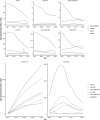Global burden of viral infectious diseases of poverty based on Global Burden of Diseases Study 2021
- PMID: 39380070
- PMCID: PMC11459951
- DOI: 10.1186/s40249-024-01234-z
Global burden of viral infectious diseases of poverty based on Global Burden of Diseases Study 2021
Abstract
Background: Viral infectious diseases of poverty (vIDPs) remain a significant global health challenge. Despite their profound impact, the burden of these diseases is not comprehensively quantified. This study aims to analyze the global burden of six major vIDPs, including coronavirus disease 2019 (COVID-19), HIV/AIDS, acute hepatitis, dengue, rabies, and Ebola virus disease (EVD), using data from the Global Burden of Diseases, Injuries, and Risk Factors Study 2021 (GBD 2021).
Methods: Following the GBD 2021 framework, we analyzed the incidence, mortality, and disability-adjusted life years (DALYs) of the six vIDPs across 204 countries and territories from 1990 to 2021. We examined the association between the Socio-Demographic Index (SDI) and the burden of vIDPs. All estimates were reported as numbers and rates per 100,000 population, calculated using the Bayesian statistical model employed by GBD 2021, with 95% uncertainty intervals (UI).
Results: In 2021, vIDPs caused approximately 8.7 million deaths and 259.2 million DALYs, accounting for 12.8% and 9.0% of the global all-cause totals, respectively. Globally, the burden of vIDPs varied significantly: COVID-19 caused around 7.9 million (95% UI: 7.5, 8.4) deaths and 212.0 million (95% UI 197.9, 234.7) DALYs in 2021. Acute hepatitis had the second-highest age-standardized incidence rate, with 3411.5 (95% UI: 3201.8, 3631.3) per 100,000 population, while HIV/AIDS had a high age-standardized prevalence rate, with 483.1 (95% UI: 459.0, 511.4) per 100,000 population. Dengue incidence cases rose from 26.5 million (95% UI: 3.9, 51.9) in 1990 to 59.0 million (95% UI: 15.5, 106.9) in 2021. Rabies, although reduced in prevalence, continued to pose a significant mortality risk. EVD had the lowest overall burden but significant outbreak impacts. Age-standardized DALY rates for vIDPs were significantly negatively correlated with SDI: acute hepatitis (r = -0.8, P < 0.0001), rabies (r = -0.7, P < 0.0001), HIV/AIDS (r = -0.6, P < 0.0001), COVID-19 (r = -0.5, P < 0.0001), dengue (r = -0.4, P < 0.0001), and EVD (r = -0.2, P < 0.005).
Conclusions: VIDPs pose major public health challenges worldwide, with significant regional, age, and gender disparities. The results underscore the need for targeted interventions and international cooperation to mitigate the burden of these diseases. Policymakers can use these findings to implement cost-effective interventions and improve health outcomes, particularly in regions with high or increasing burdens.
Keywords: Disability-adjusted life years; Global Burden of Disease 2021; Socio-Demographic Index; Viral infectious diseases of poverty.
© 2024. The Author(s).
Conflict of interest statement
The authors declare that they have no competing interests.
Figures





Similar articles
-
Global, regional, and national deaths, prevalence, disability-adjusted life years, and years lived with disability for chronic obstructive pulmonary disease and asthma, 1990-2015: a systematic analysis for the Global Burden of Disease Study 2015.Lancet Respir Med. 2017 Sep;5(9):691-706. doi: 10.1016/S2213-2600(17)30293-X. Epub 2017 Aug 16. Lancet Respir Med. 2017. PMID: 28822787 Free PMC article.
-
Prevalence and attributable health burdens of vector-borne parasitic infectious diseases of poverty, 1990-2021: findings from the Global Burden of Disease Study 2021.Infect Dis Poverty. 2024 Dec 11;13(1):96. doi: 10.1186/s40249-024-01260-x. Infect Dis Poverty. 2024. PMID: 39658783 Free PMC article.
-
Global, regional, and national burden of allergic disorders and their risk factors in 204 countries and territories, from 1990 to 2019: A systematic analysis for the Global Burden of Disease Study 2019.Allergy. 2023 Aug;78(8):2232-2254. doi: 10.1111/all.15807. Epub 2023 Jul 11. Allergy. 2023. PMID: 37431853 Free PMC article.
-
Global, regional, and national burden of asthma and atopic dermatitis, 1990-2021, and projections to 2050: a systematic analysis of the Global Burden of Disease Study 2021.Lancet Respir Med. 2025 May;13(5):425-446. doi: 10.1016/S2213-2600(25)00003-7. Epub 2025 Mar 24. Lancet Respir Med. 2025. PMID: 40147466
-
Cancer Incidence, Mortality, Years of Life Lost, Years Lived With Disability, and Disability-Adjusted Life Years for 29 Cancer Groups From 2010 to 2019: A Systematic Analysis for the Global Burden of Disease Study 2019.JAMA Oncol. 2022 Mar 1;8(3):420-444. doi: 10.1001/jamaoncol.2021.6987. JAMA Oncol. 2022. PMID: 34967848 Free PMC article.
Cited by
-
[ART adherence and its association with depression, anxiety and stress].Rev Med Inst Mex Seguro Soc. 2025 Mar 3;63(2):e6553. doi: 10.5281/zenodo.14616894. Rev Med Inst Mex Seguro Soc. 2025. PMID: 40273326 Free PMC article. Spanish.
-
Harnessing Antiviral Peptides: From Molecular Mechanisms to Clinical Translation.Curr Res Pharmacol Drug Discov. 2025 Jul 15;9:100228. doi: 10.1016/j.crphar.2025.100228. eCollection 2025. Curr Res Pharmacol Drug Discov. 2025. PMID: 40718095 Free PMC article. Review.
-
One Health: enabler of effective prevention, control and elimination of emerging and re-emerging infectious diseases.Infect Dis Poverty. 2025 Jul 31;14(1):77. doi: 10.1186/s40249-025-01337-1. Infect Dis Poverty. 2025. PMID: 40745334 Free PMC article. Review.
-
The global, regional, and national burden trends of dengue among adults aged 20-49 from 1990 to 2021.Sci Rep. 2025 Jul 23;15(1):26761. doi: 10.1038/s41598-025-10824-2. Sci Rep. 2025. PMID: 40702040 Free PMC article.
-
Global, regional, and national burden of upper respiratory infections, 1990-2021: Findings from the Global Burden of Disease study 2021.Sci One Health. 2024 Oct 22;3:100084. doi: 10.1016/j.soh.2024.100084. eCollection 2024. Sci One Health. 2024. PMID: 39559454 Free PMC article.
References
-
- Collaborators GRF. Global, regional, and national comparative risk assessment of 84 behavioural, environmental and occupational, and metabolic risks or clusters of risks for 195 countries and territories, 1990–2017: a systematic analysis for the Global Burden of Disease Study 2017. Lancet. 2018;392(10159):1923–94. - PMC - PubMed
-
- Jebril N. World Health Organization declared a pandemic public health menace: a systematic review of the coronavirus disease 2019 “COVID-19”. Available at SSRN 3566298. 2020.
MeSH terms
Grants and funding
- 72204160/National Natural Science Foundation of China
- 21410750200/International Joint Laboratory on Tropical Diseases Control in Greater Mekong Subregion
- NHCKFKT2022-16/Open Research Project of the Key Laboratory of Parasite Pathogen and Vector Biology of National Health Commission of the People's Republic of China
LinkOut - more resources
Full Text Sources
Medical

